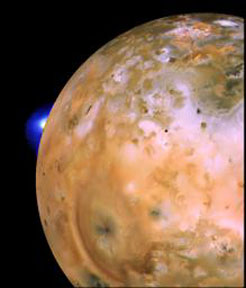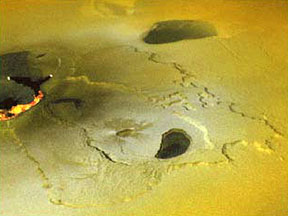Click on image for full size
Courtesy of NASA
Related links:
Chlorine Found in Io Atmosphere Leads to Salt?
News story originally written on June 4, 1999
Scientists at the University of Colorado at Boulder found evidence supporting a theory that salt is present on Io. Io is one of Jupiter's many moons. Recent observations from the National Science Foundation's Kitt Peak National Observatory in Arizona led to the discovery of chlorine in Io's atmosphere.
Chlorine(Cl) along with sodium(Na) makes sodium chloride(NaCl), also known as common table salt. Salt is a very important mineral. The proportion of chlorine in Io's atmosphere is billions of times larger than Earth's, making it the celestial body with the highest amount of Cl in our solar system.
"In fact, Io seems to have a higher proportion of chlorine in its atmosphere than any other object in the solar system," said CU-Boulder Associate Professor Nick Schneider. "The huge volcanoes on Io are similar to giant geysers, spewing material hundreds of miles into the atmosphere."
On Earth, most salt is produced when salt water evaporates. Scientists believe there may be underwater rivers on the moon producing the NaCl. It may also be produced by chemical reactions in Io's atmosphere.
Chlorine is a very important gas that breaks down ozone in Earth's atmosphere. This knowledge will help scientists understand Io's atmosphere and may eventually lead to a better understanding of our own environment.
"Chemical reactions may actually produce salt in the atmosphere," Schneider said. "The study of chlorine on Io is sure to benefit from the extensive research on Earth's ozone hole, which in turn benefited from the study of chlorine in the atmospheres of other planets."















